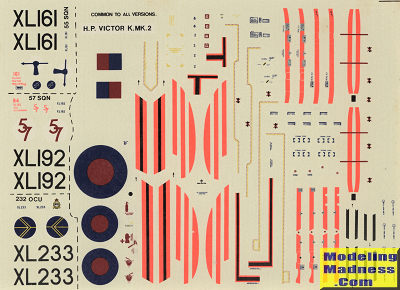The Handley Page Victor was one of three 'V bombers' along with the
Valiant and Vulcan, which were designed to provide the UK's nuclear
deterrent during the Cold War. The type served for many years in this role.
What the RAF didn't have was a reliable tanker. The Valiant was the slowest
of the three bombers and the fleet provided the first tanker conversions.
However, the Valiant suffered from metal fatigue and so it fell to the
Victor to help fulfill this role. Thus the Victor K.1 was developed from
surplus Victor B.1 aircraft.
The remaining B.2 aircraft were not as suited to the low-level mission
profile that the RAF had adopted for carrying out strategic bombing missions
as the Vulcan with its stronger delta wing. This, combined with the switch
of the nuclear deterrent from the RAF to the Royal Navy (with the Polaris
missile) meant that the Victors were declared surplus to
requirements. Hence, 24 B.2 were modified to K.2 standard. Similar to the
K.1/1A conversions, the wing, which was to have been fitted with tip fuel
tanks to reduce wing fatigue, had 18 inches removed from each tip instead
and the bomb aimer's nose glazing was replaced with metal. During 1982, the
glazing was reintroduced on some aircraft, the former nose bomb aimer's
position having been used to mount F95 cameras in order to perform
reconnaissance missions during the Falklands War. The K.2 could carry
91,000 lb (41,000 kg) of fuel. It served in the tanker role until withdrawn
in October 1993.
Typical of Matchbox kits, this one
is in three shades of plastic; green, white, and grey. The external
detailing is quite well done, but of the raised panel line variety. Other
detailing is fairly Spartan as was typical of Matchbox products.
The cockpit is simply five seat shapes with crew to fit into them.
This is because little will be seen through the small and fairly thick
windscreen panes. Then the instructions have you building subassemblies. This
includes the outer wing sections (with separate ailerons), fin, inner wing
sections tailplanes, wing tanks, and HDUs before installing the cockpit into the
fuselage halves. No indication of weight is provided, but I'd add some just to
be sure.
Then we come to the first optional part. This is the tail brake.
This can be built with the brakes open or closed. The other option (aside from
gear up or down) is the separate flaps. For the lowered position, a bit of
cutting is required. Another interesting option is for the drogues to be
extended, though this wouldn't be used for anything but an in-flight display.
 Landing gear are sturdy, though like the gear wells, lacking
finesse. Other bits like the canopy piece, various scoops, the pitot heads and a
crew entry door will finish off the model.
Landing gear are sturdy, though like the gear wells, lacking
finesse. Other bits like the canopy piece, various scoops, the pitot heads and a
crew entry door will finish off the model.
Instructions are nicely drawn and as was the norm for these kits,
all the various bits that need painting are condensed into a chart at the end of
the instructions. Three schemes are provided, all in dark green/medium grey over
light grey. All three units that flew the tanker version are provided, and that
includes 55 Sq, 57 Sq, and 232 OCU. The decal sheet is nicely done, but I'm not
sure how viable it is after so many years. You can find aftermarket if you wish.


